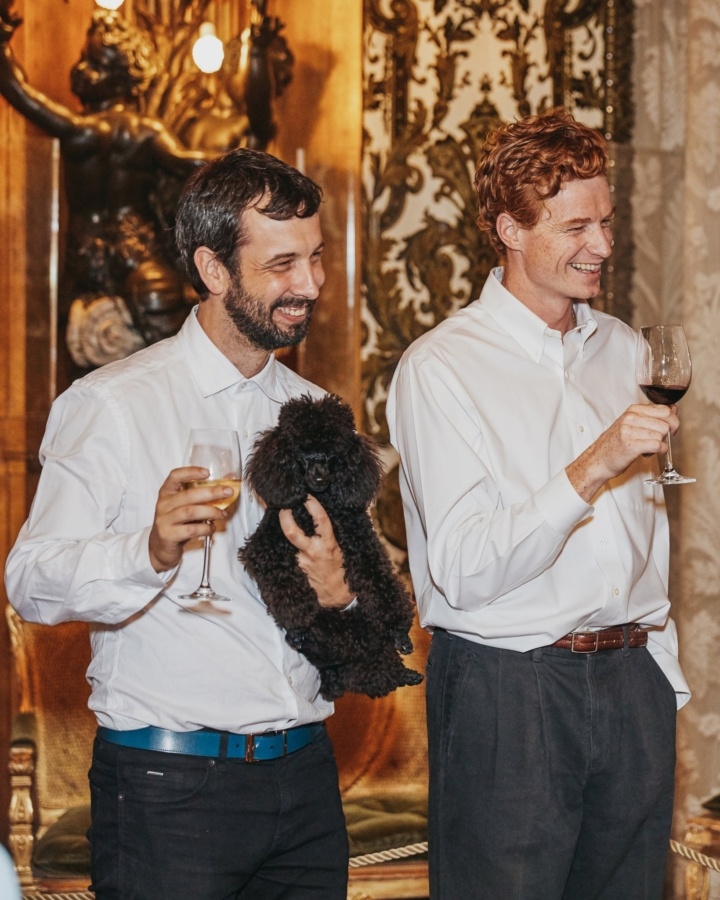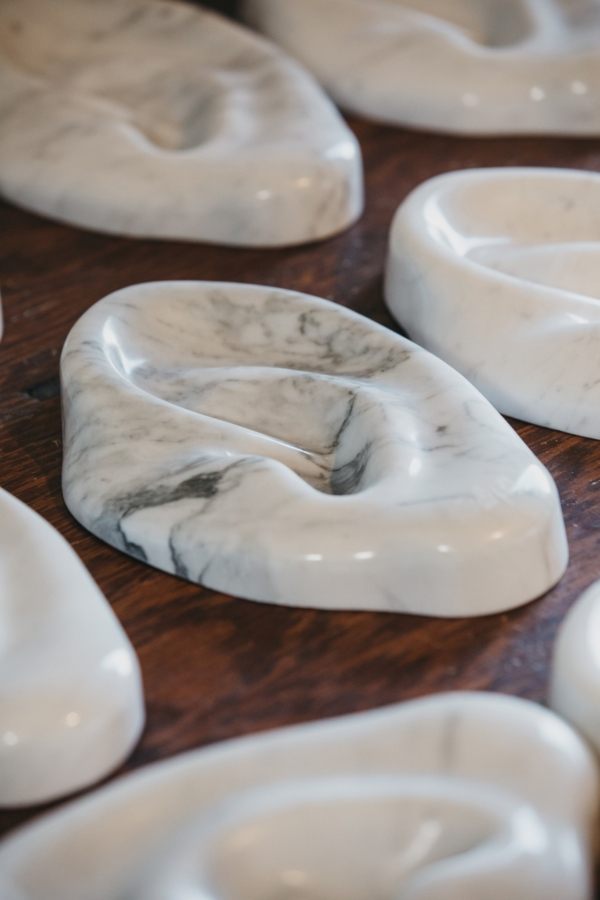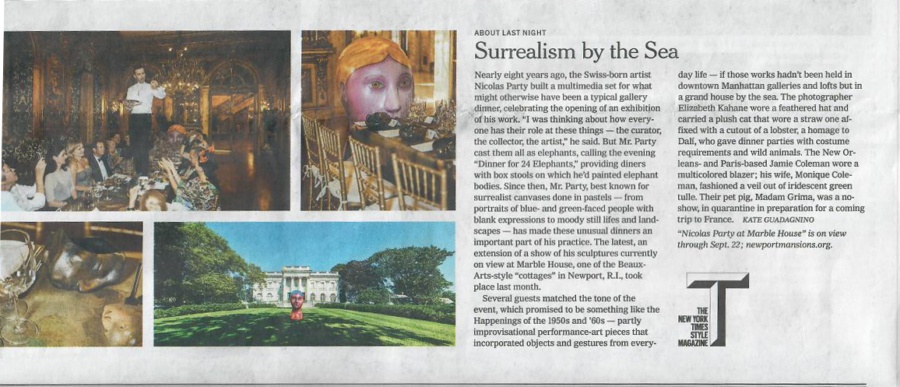August 28, 2019
Download as PDF
View on The New York Times
The artist Nicolas Party took over Marble House in Newport, R.I., to stage a surrealist performance piece complete with four courses, live opera — and a goldfish.
Nearly eight years ago, the Swiss-born artist Nicolas Party built a multimedia set for what might otherwise have been a typical gallery dinner celebrating the opening of an exhibition of his work. “I was thinking about how everyone has their role at these things — the curator, the collector, the artist,” he said. But Party cast them all as elephants, titling the evening “Dinner for 24 Elephants,” providing diners with box stools on which he’d painted elephant bodies and deflating a social ritual even as he elevated it to the level of art. Since then, Party, who is 39 and best known for his surrealist canvases done in soft pastels — from portraits of blue- and green-faced people with blank expressions to moody still lifes and landscapes (in one, a pair of trees stretch toward the moon like houseplants in want of the sun) — has made these unusual dinners an important part of his practice. The latest, an extension of a show of his sculptures currently on view at Marble House, one of Newport’s Beaux-Arts-style “cottages,” took place earlier this month.

Several guests matched the tone of the event, which promised to be something like the Happenings of the 1950s and ’60s — partly improvisational performance-art pieces that incorporated objects and gestures from everyday life — if those works hadn’t been held in downtown Manhattan galleries and lofts but in a grand house by the sea. The photographer Elizabeth Kahane wore a feathered hat and carried a plush cat that wore a straw one affixed with a cutout of a lobster, a homage to Salvador Dalí, who threw eccentric dinner parties with costume requirements, wild animals and dishes like thousand-year-old eggs. The New Orleans- and Paris-based Jamie Coleman had on a multicolored checkered blazer; his wife, Monique Coleman, had fashioned a veil out of iridescent green tulle, which she paired with a vintage red dress and blue lipstick. The couple’s pet pig, Madam Grima, was a no-show, as she was in quarantine in preparation for an upcoming trip to France.
During cocktails, attendees had a chance to see the show. Party’s work is already layered with nods to various chapters of art history — it’s been compared to that of René Magritte and Giorgio Morandi — but, set within the opulent period rooms of Marble House, which was designed in the 1880s for Alva and William K. Vanderbilt, his sculptures looked shockingly fresh, their painted surfaces gleaming as much as any gilded trinket or molding. The setting highlighted the pieces’ strangeness while they, in turn, underlined the strangeness of great wealth, proof of which is never out of sight at the house. In Alva Vanderbilt’s Rococo-style bedroom, one nearly four-foot sculpture of a finger lay diagonally on the canopied bed and another rested on the daybed. Downstairs, amid the stained glass, oak paneling and carved stone chimney piece of a Gothic-style sitting room, was a tangerine foot about the size of a small car. And so it went, each room its own comment on taste and time. “Nicolas pulls you back, and then he pushes you forward,” said Dodie Kazanjian, the curator of the show and the dinner, which, given the artist’s surname, she considered to be a form of self-portraiture — and which was announced with the chime of a triangle.
 CreditCaroline Goddard for Tom Powel Imaging
CreditCaroline Goddard for Tom Powel Imaging
The night’s primary stage, the dining table, was covered with a canvas cloth printed to mirror the allegorical painting on the ceiling (Hugues Taraval’s “Athena Rescuing a Youth From Idleness”) — “as above, so below,” said the artist Leo Villareal, who, along with Chloë Sevigny, Jean Vanderbilt and the artist Elizabeth Colomba, was one of 24 seated guests — as well as ceramic bowls by the artist Jesse Wine that approximated human heads, their hollows filled with chilled pea-and-ginger soup. Party, Kazanjian and Brendan Dugan, the founder of Karma, Party’s New York gallery, were among those playing waiters. Dressed in white shirts and black pants, they moved according to a choreographic score, filing in wordlessly and standing upright behind the chairs before serving or removing dishes in unison. They proved too competent to be agents of chaos but, just as things began to feel very comfortable, one of Wine’s bowls crashed onto the floor. Anthony Roth Costanzo, the celebrated countertenor who will star in Philip Glass’s “Akhnaten” at the Metropolitan Opera in November but was in this instance playing the butler, began picking up the pieces and placing them on a silver tray — all while singing John Dowland’s mournful 1605 work “In Darkness Let Me Dwell” to live theorbo accompaniment. Costanzo then produced a live goldfish, dropped it into a glass of water and took a drink. It was some time before normal dinner conversation resumed.

Caroline Goddard for Tom Powel Imaging
Following a few other courses — halibut ceviche presented on foot-shaped pedestals by Party, spatchcock quail atop face-like plates by Wine — the waiters cleared a long, narrow path across the table. The consensus was that some sort of well-trained creature, whether a rabbit, a cockroach or a python, would make its way from one end to the other. In the end, it was Costanzo, who removed his jacket and shoes before stepping onto the table and crooning the first spellbinding notes of George Gershwin’s “Summertime.” As he sang, he tiptoed between crystal glasses and threw handfuls of caramel corn in the direction of people’s dessert plates. “There’s always something kind of unhinged about characters in the opera, so it felt pretty natural,” said Costanzo, though he added that he was worried about the color of his socks, which were cerulean.
“It all teetered on the brink of being debauched — there was an aura of decadent Rome,” said Alanna Heiss, the founder of MoMA PS1 and director of the arts nonprofit Clocktower Productions, “but my feeling is you can be as silly as you want as long as it wakes people up to thinking.” Dugan also spoke of how Party’s work balances cheekiness with rigor: “You can sense that you are a part of a bigger project,” he said. Of course, there’s always a contract between performer and audience member, roles that can be more or less distinct depending on the nature of the work. Here, though, it was clear that the diners were key players. “It’s the visitors who bring it alive,” Kazanjian said of both the happening and the house, this tomblike space where it’s impossible not to conduct mental resurrections of former occupants. Fittingly, the event was titled “Dinner With Ghosts.”
Now the dinner, too, is a thing of the past. “A physical painting or sculpture can take a year, and then it exists,” Party said. “With this, you have a window where everything happens and once it’s over, it’s over.” Indeed, after the last guests said their goodbyes, Party, Wine, his wife — the artist Cassandre Griffin — and Costanzo, perhaps inspired by the full moon, went for a late-night ocean swim in the nude. The goldfish and its understudies, meanwhile, were returned to a garden lily pond nearby.




